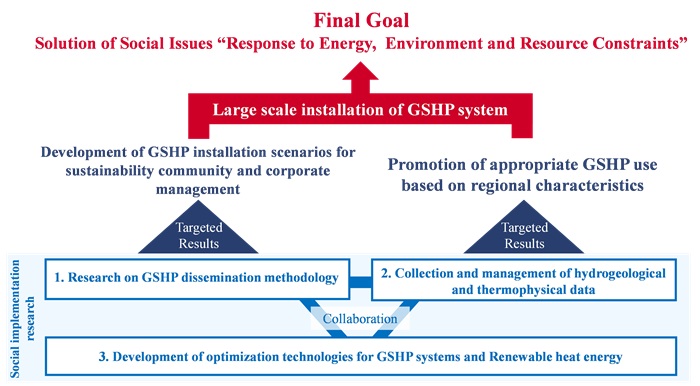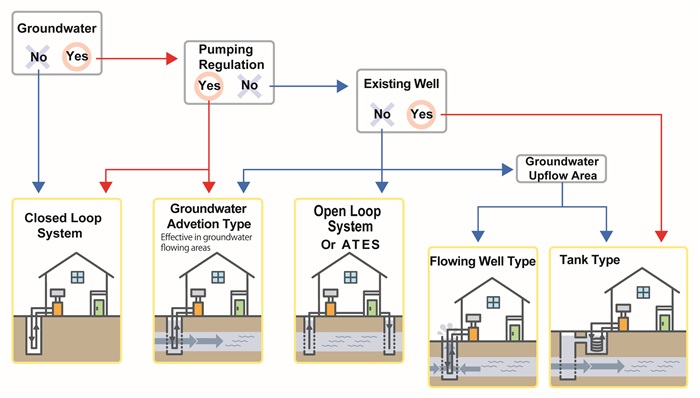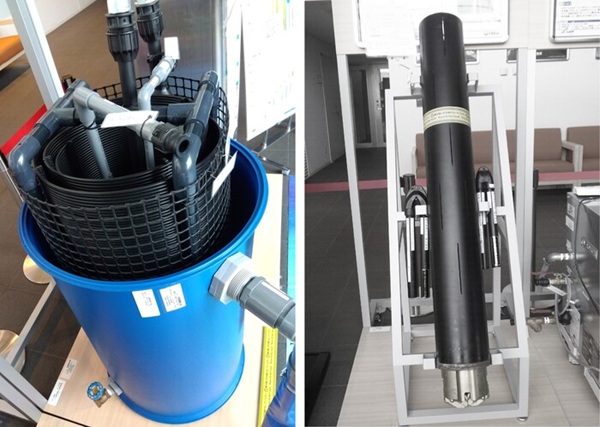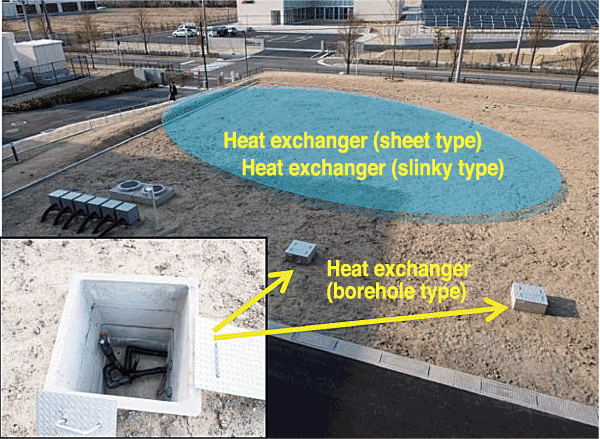Shallow Geothermal and Hydrogeology Research Team
Social implementation research contributing to the promotion and appropriate use of shallow geothermal heat
Overview
Shallow geothermal heat is a renewable energy heat source that utilizes the stable underground temperature environment, which is higher in winter and lower in summer compared to the temperature above ground, for cooling, heating, hot water supply, snow melting, and other heat sources.
Systems that use shallow geothermal heat for air conditioning, etc. (shallow geothermal heat utilization systems) are expected to provide high energy savings and decarbonization benefits.
However, understanding the subsurface environment is essential for proper implementation of shallow geothermal heat utilization systems, since the “underground thermal environment” and “underground heat transfer characteristics,” which are important points when using shallow geothermal heat, are determined by the geology and groundwater, which are highly variable in each region.
In addition, practical efforts (social implementation research) based on “understanding the user needs” and “approaches that lead to steady diffusion” are required for more people to use shallow geothermal heat.
Research Target
The ultimate goal of this team is to solve the “social issue: addressing energy, resources and environmental constraints” by achieving mass introduction of ground source heat pump (GSHP) systems.
Therefore, we are conducting various studies that will lead to the steady promotion and mass introduction of shallow geothermal heat based on our expertise in geology and groundwater, with the first two research outcomes to be aimed at: “development and provision of geothermal heat introduction scenarios for sustainable community and business management” and “promotion of appropriate use of shallow geothermal heat according to regional characteristics” (Fig.1).

Research Outline
Social implementation research of shallow geothermal heat
Our team is conducting social implementation research under the following three themes.
Through these research activities, we will promote the spread and appropriate use of shallow geothermal heat, and contribute to the expansion of GSHP systems introduction and the construction of a database.
Research on GSHP dissemination methodology
We are conducting research and development on methodologies for spreading the use of shallow geothermal heat, recognizing an issue of "information that the users want is not being provided" which needs to be resolved.
Specifically, we are developing technologies for evaluating geothermal potential and suitable sites for geothermal heat utilization, evaluating the economic and environmental benefits of introducing GSHP systems , and studying measures to improve the social acceptability of shallow geothermal heat.
Collection and management of hydrogeological and thermophysical data
In order to properly design a GSHP system, it is necessary to estimate the “apparent thermal conductivity” (the thermal conductivity including the effect of groundwater flow) of the geological strata in the area of installation.
If an apparent thermal conductivity map of the target area is prepared in advance, cost evaluation, project evaluation, system schematic design, etc. can be performed prior to system installation.
Therefore, our team is developing a method for estimating apparent thermal conductivity over a wide area and in a 3 dimensional regional scale based on hydrogeological knowledge.
We are also developing a low cost apparent thermal conductivity estimation test methods.
Utilization of these development results is expected to reduce costs related to system design and project evaluation.
Development of optimization technologies for GSHP systems and Renewable heat energy
We are developing an integrated simulator for economic evaluation and proper design of GSHP systems.
In addition, we are also conducting demonstration research and technological improvements to increase the probability of social implementation of the thermophysica properties investigation and analysis technology, high-efficiency heat exchange technology, and unique GSHP systems that we have developed so far.
Additionally, in order to present a new way of spreading shallow geothermal heat, we are evaluating the usefulness of its utilization in Asian countries where cooling demand is outstanding, and conducting demonstration research to establish and commercialize agricultural greenhouse cultivation technology in Japan.
Activities and Achievements
Study of methodologies for promoting shallow geothermal heat: Suitability Map
We are creating a suitability map, information that visualizes the potential use of shallow geothermal heat by comprehensively evaluating the geology and groundwater environment of the target area (Fig.2).
In Japan, the number of GSHP systems installed tends to be high in regions with large heating loads, such as Hokkaido, Tohoku, and Shin’etsu regions, but we created and published a suitabilityl map for the Osaka Plain, which has a large cooling load compared to these regions (Fig.3 and 4).

(closed-loop system)

(closed-loop system: distribution of required heat exchanger length)

Development of hydrogeological and thermophysical property data: Apparent thermal conductivity in Fukushima Prefecture
In collaboration with a group of companies in Fukushima Prefecture, we have developed an in-situ test method called “cable-type thermal response test,” which is less expensive than the conventional in-situ test used to estimate apparent thermal conductivity.
We conducted field investigations using cable-type thermal response tests at 47 sites in Fukushima Prefecture and empirically confirmed
its effectiveness by comparing by comparing the estimated values with those of conventional testing methods (Fig. 5).

Development of optimization technologies for GSHP systems and Renewable heat energy : High-efficiency heat exchangers
We are working with several companies to develop “high-efficiency heat exchangers” that have lower installation costs and higher heat exchange efficiency compared to conventional systems.
By selecting a heat exchanger that is appropriate for the local groundwater environment (e.g., presence/absence of groundwater pumping restrictions, groundwater up-flow areas, etc.), installation costs can be significantly reduced (Fig. 6 and 7).


(left: tank-type heat exchanger, right: groundwater advection type heat exchanger)
Main Research Facilities
FREA GSHP system demonstration test site
This GSHP system utilizes two types of horizontally buried heat exchangers installed at a depth of 1 to 2m and a vertically buried heat exchanger (borehole type) at a depth of approximately 40 m and 100 m.

Team Member
| Title | Name |
|---|---|
| Leader, Team | TOMIGASHI Akira |
| Senior Researcher | SHRESTHA Gaurav |
| Senior Researcher | ISHIHARA Takeshi |
| Senior Researcher | NAKAYAMA Hiroyuki |
| Researcher | SHIMADA Yutaro |
| Attached to Research Team | UCHIDA Youhei |
| Attached to Research Team | YOSHIOKA Mayumi |
| Attached to Research Team | ONO Masahiko |
| Attached to Research Team | JINGUUJI Motoharu |
